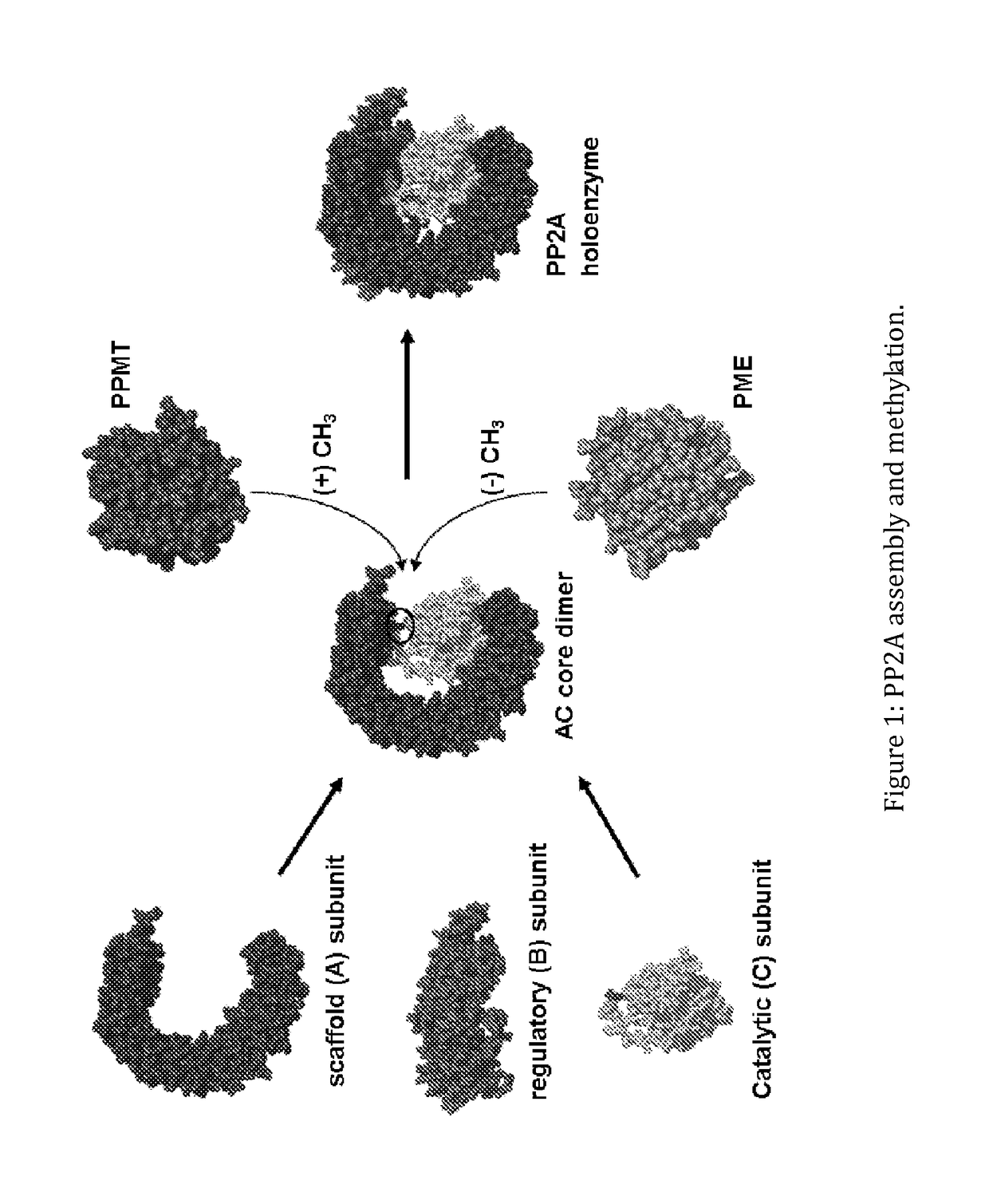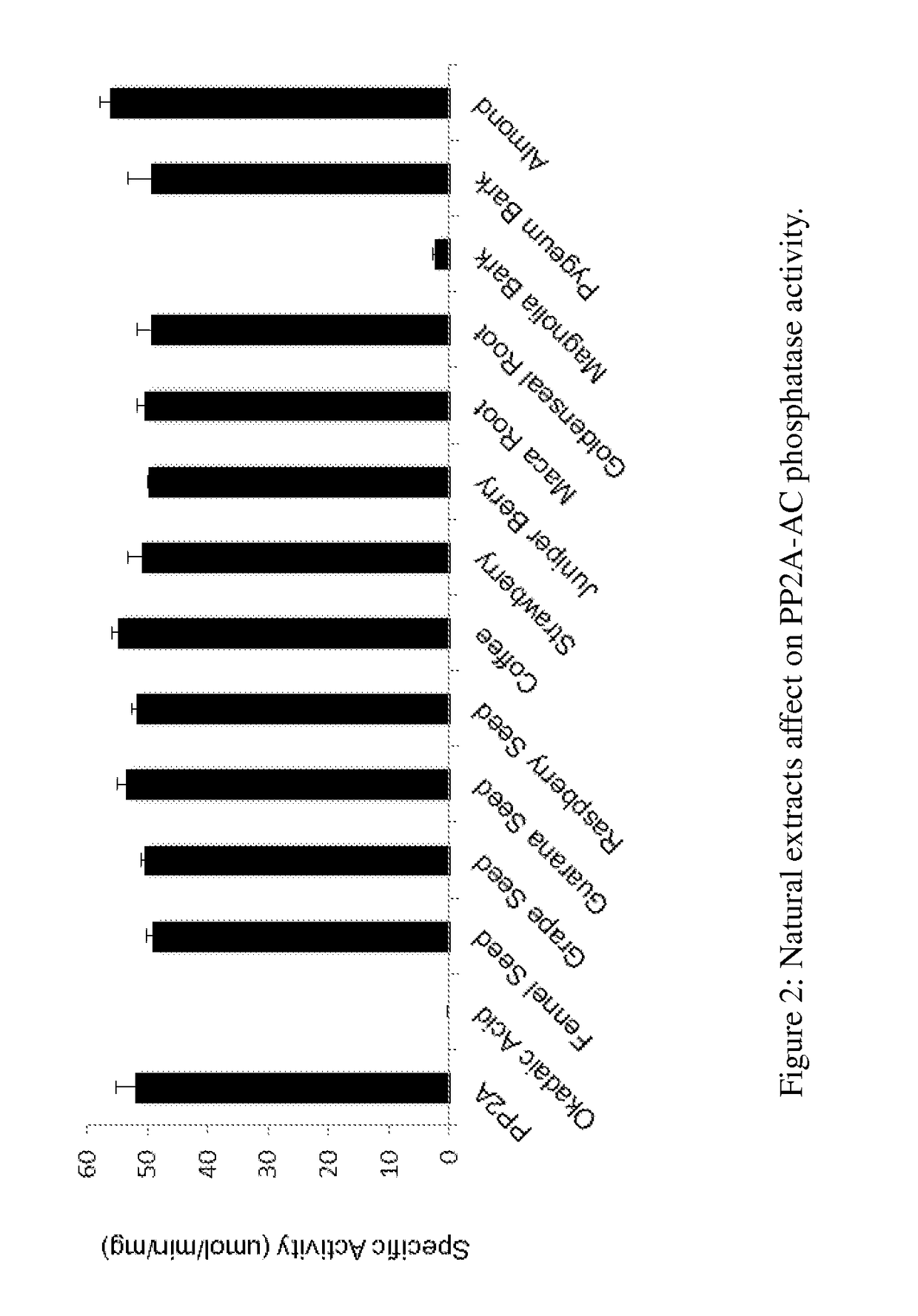Natural extracts for modulating pp2a methylation, and providing antioxidant and anti inflammatory activity
a technology of pp2a methylation and natural extracts, which is applied in the directions of pharmaceutical delivery mechanism, plant/algae/fungi/lichens ingredients, coniferophyta medical ingredients, etc., can solve the problem of needing ad therapies
- Summary
- Abstract
- Description
- Claims
- Application Information
AI Technical Summary
Benefits of technology
Problems solved by technology
Method used
Image
Examples
example 1
Preparation of Extracts
[0148]Various water-soluble oligosaccharides and starch in botanicals can reduce the specific activity of the extract, making the extract prone to bacterial contamination and growth; and change its appearance to sticky thick oil or to glassy caramel-looking substance. These properties make most of aqueous extracts difficult in manufacture (drying, emptying from reactor, drumming, etc.) and affect products shelf life and overall safety. Furthermore, removing various naturally occurring in a given botanic extract non-biologically active oils and lipids result in final extract to be a free flowing powder improving ease of manufacturing and blending into a product. Therefore, a process for manufacturing these extracts was designed to take these factors into account.
[0149]A raw botanical (10 g) was shaken with isopropyl alcohol (100 mL) in a flask at 65° C. for 16 hrs. The resulting isopropanolic extract was filtered and concentrated to dryness on a rotavap. The cr...
example 2
Natural Extracts Effect on PP2A Methylation
[0150]Extracts, as shown in Tables 1-4 below, were created using isopropanol or toluene-based extraction methods at 65° C. as generally described in Example 1. These extracts were assayed for their ability to preserve the methylation status of PP2A AC dimer in the presence of protein phosphatase methylesterase-1 (PME-1), using a radioactive filter binding assay. Methylated PP2A was made by incubating PP2A, protein phosphatase methyl transferase (PPMT) and [3H]-SAM for 1 hr. PME-1 was incubated with varying concentrations of botanical extracts prior to the addition of 50 nM of methylated PP2A. The reaction was allowed to continue for 30 minutes at room temperature. 10% TCA was added to stop the reaction and incubated for 1 hour. Remaining buffer was filtered and total counts remaining on the filter plate were measured using a scintillation counter. IC50 values were generated from dose-response curves using a four-parameter logistic curve fit...
example 3
Natural Extracts Effect on ROS Scavenging (Antioxidant)
[0153]Botanical extracts ability to prevent oxidation of ABTS by metmyoglobin was analyzed. The antioxidant capacity of select botanical extracts was evaluated in vitro using the ABTS (2, 2′-Azino-bis-[3-ehthylbenzthiazoline sulphonate]) antioxidant kit (Cayman Chemical Company; Ann Arbor, Mich.). Botanical extracts were incubated with both metmyoglobin and chomogen, ABTS. The reaction was initiated upon addition of hydrogen peroxide and the oxidation of the ABTS to ABTS•+ was monitored via absorbance at 750 nm. EC50 values were generated from dose-response curves using a four-parameter logistic curve fit (SigmaPlot), and are shown below in Table 5.
PUM
 Login to View More
Login to View More Abstract
Description
Claims
Application Information
 Login to View More
Login to View More - R&D
- Intellectual Property
- Life Sciences
- Materials
- Tech Scout
- Unparalleled Data Quality
- Higher Quality Content
- 60% Fewer Hallucinations
Browse by: Latest US Patents, China's latest patents, Technical Efficacy Thesaurus, Application Domain, Technology Topic, Popular Technical Reports.
© 2025 PatSnap. All rights reserved.Legal|Privacy policy|Modern Slavery Act Transparency Statement|Sitemap|About US| Contact US: help@patsnap.com


